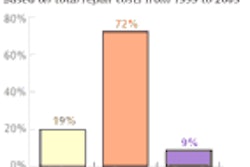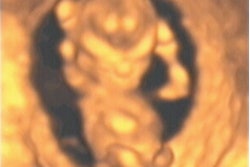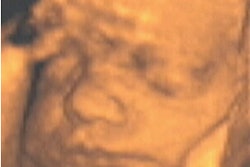(Radiology Review) According to radiologists at University of Michigan Medical Center in Ann Arbor, secondary ultrasound findings, including greater tuberosity cortical irregularity and joint fluid, are the best predictors of supraspinatus tendon (SST) tear.
Published in Radiology, their study determined which ultrasound signs were the most important in patients with SST tears requiring surgical repair.
"Fifty consecutive ultrasonographic studies of the shoulder in patients who underwent arthroscopic follow-up were retrospectively reviewed by a musculoskeletal radiologist," wrote Dr. Jon Jacobson. The ultrasound images obtained were evaluated for tendon presence, abnormal echogenicity, thinning, irregularity of the greater tuberosity, cartilage interface sign, fluid around the biceps brachii tendon, and fluid in the subacromial-subdeltoid bursa.
Cortical irregularity was revealed in 86% of patients with full-thickness SST tears, 40% of patients with bursal side partial-thickness tears, and 50% of patients with articular side partial-thickness tears.
The cartilage interface sign was described as a thin, markedly hyperechoic line at the surface of the hypoechoic, hyaline articular cartilage of the humeral head. This sign was shown in 33% of patients with full thickness tears. However, according to the authors, this sign also can depict normal anatomy. Therefore, they recommended this sign be used in patients where the interface is markedly hyperechoic because of fluid overlying the articular cartilage.
It is important to note that this study was performed over an 18-month period that began eight years ago. The equipment used included an ATL 3000 and an AI 5200, neither of which would currently be considered adequate for musculoskeletal imaging.
Twenty-one full-thickness tears, five bursal surface partial thickness tears, and 10 articular surface partial-thickness tears were found at arthroscopy. Fourteen patients had no SST tear.
"For diagnosis of any type of SST tear (partial or full thickness), tendon nonvisualization, greater tuberosity cortical irregularity, and cartilage interface sign are most important, though a combination of signs did not improve accuracy," they concluded.
Full-thickness and partial-thickness supraspinatus tendon tears: value of US signs in diagnosisJacobson, JA, et al
Department of radiology, University of Michigan Medical Center, Taubman Center, Ann Arbor, MI
Radiology 2004 January; 230:234-242
By Radiology Review
February 25, 2004
Copyright © 2004 AuntMinnie.com



















